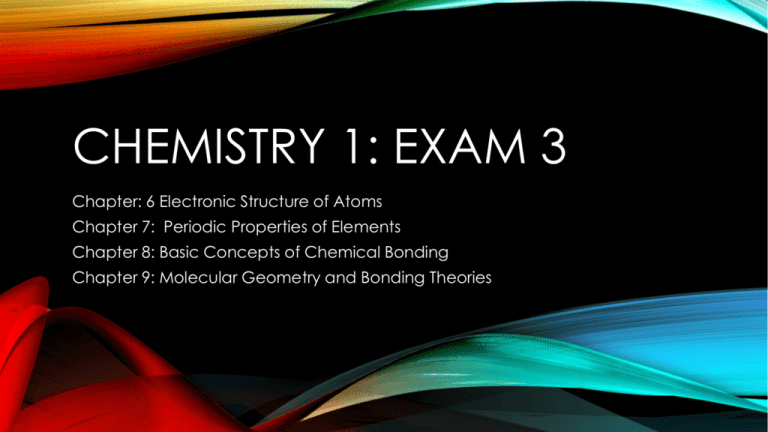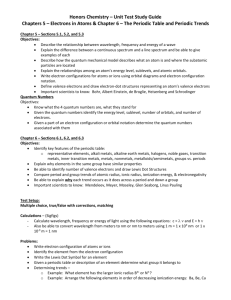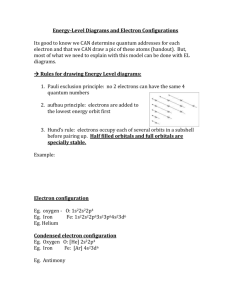Chemistry 1: Exam 3
advertisement

CHEMISTRY 1: EXAM 3 Chapter: 6 Electronic Structure of Atoms Chapter 7: Periodic Properties of Elements Chapter 8: Basic Concepts of Chemical Bonding Chapter 9: Molecular Geometry and Bonding Theories CHAPTER 6: ELECTRONIC STRUCTURE OF ATOMS • 6.1: The Wave Nature of Light • 6.2: Quantized Energy and Photons • 6.3: Line Spectra and the Bohr Model • 6.4: The Wave Behavior of Matter • 6.5: Quantum Mechanics and Atomic Orbitals • 6.6: Representation of Orbitals • 6.7: Many Electron Atoms • 6.8: Electron Configurations • 6.9: Electron Configurations and the Periodic Table 6.1 THE WAVE NATURE OF LIGHT • Electromagnetic Radiation: • Carries energy through space as waves Radiant Energy • All electromagnetic radiation moves at the speed of light • • • • 𝑐𝑐 = 𝜆𝜆𝜈𝜈 c = 3.00 * 10^8 m/s λ = wavelength (nm) ν = frequency (Hz or 1/s) 6.2: QUANTIZED ENERGY AND PHOTONS • Wave model cannot explain all behavior or energy • Black Body Radiation: light emitted from hot objects • Photoelectric Effect: electrons being emitted from metal surfaces • Emission Spectra: emission of light from excited gas atoms • Quantum: Amount of energy that can be emitted or absorbed as electromagnetic radiation • Energy can only be emitted in strict quantum • Work Function: energy required to overcome attractive forces holding it in a metal form • 𝐸𝐸 = ℎ𝜈𝜈 • E = Energy of a single quantum or photon • ℎ = 6.626 ∗ 10−34 J-s 6.3: LINE SPECTRA AND THE BOHR MODEL • Continuous Spectrum: contains light of all wavelengths • Line Spectrum: Single wavelength • 𝑅𝑅𝑅𝑅𝑅𝑅𝑅𝑅𝑅𝑅𝑅𝑅𝑅𝑅 𝐸𝐸𝐸𝐸𝐸𝐸𝐸𝐸𝐸𝐸𝐸𝐸𝐸𝐸𝐸𝐸: 1 𝜆𝜆 = 𝑅𝑅ℎ • Rh = 1.096776*10^7 1/m 1 𝑛𝑛12 − 1 𝑛𝑛22 where n2>n1 and positive 6.3: LINE SPECTRA AND THE BOHR MODEL • Bohr Model 1. Distinct Orbitals with different Radii 2. Can exist only in specific orbitals with allowed energy states 3. Emission and Absorption only occurs when energy states change • Only explains Hydrogen 6.4: THE WAVE BEHAVIOR OF MATTER • 𝜆𝜆 = ℎ 𝑚𝑚𝑚𝑚 • mv = momentum • 𝑃𝑃𝑃𝑃𝑃𝑃𝑃𝑃𝑃𝑃𝑘𝑘 ′ 𝑠𝑠 𝐶𝐶𝐶𝐶𝐶𝐶𝐶𝐶𝐶𝐶𝐶𝐶𝐶𝐶𝐶𝐶: ℎ = 6.626 ∗ 10−34 𝐽𝐽 − 𝑠𝑠 • Uncertainty Principle • Δ𝑥𝑥 ∗ Δ(𝑚𝑚𝑚𝑚) ≥ ℎ 4𝜋𝜋 6.5: QUANTUM MECHANICS AND ATOMIC ORBITALS • Orbital: Distribution of electrons 1. Principal Quantum Number: increase in n = higher energy =less tightly bound to nucleus • Same Orbital =Electron Shell 2. Angular Momentum Quantum Number = s=0, p=1, d=2, f=3 3. Magnetic Quantum Number: Describes orientation 6.6 REPRESENTATION OF ORBITALS • S Orbital • Lowest Energy Orbital • Spherically Symmetric • Radial probability Function n=1 6.6 REPRESENTATION OF ORBITALS n=2 n=3 or more 6.7: MANY ELECTRONS ATOMS Electron Spin 1 1 • + ,− 2 2 Pauli Exclusion Principle • Filled in order of increasing energy 6.8: ELECTRON CONFIGURATIONS • Hund’s Rule: Put one electron in each orbital until the full 6.9: ELECTRON CONFIGURATION AND THE PERIODIC TABLE 6.9: ELECTRON CONFIGURATION AND THE PERIODIC TABLE • Example: • Ga [Ar] 3d10 4s2 4p1 • Pb [Xe] 4f14 5d10 6s2 6p2 CHAPTER 7: PERIODIC PROPERTIES OF THE ELEMENTS • 7.1: Development of the Periodic Table • 7.2: Effective Nuclear Charge • 7.3: Sizes of Atoms and Ions • 7.4: Ionization Energy • 7.5: Electron Affinities • 7.6: Metals, Nonmetals and Metalloids • 7.7: Group Trends and the Active Metals • 7.8: Group Trends for Selected Nonmetals Valence Orbitals (Columns) 7.1: DEVELOPMENT OF THE PERIODIC TABLE Important People • Mendeleev • Meyer • Rutherford • Moseley 7.2: EFFECTIVE NUCLEAR CHARGE • 𝑍𝑍𝑒𝑒𝑒𝑒𝑒𝑒 = 𝑍𝑍 − 𝑆𝑆 • Zeff = Effective Nuclear Charge • Net attraction to the Nucleus • Z=Number of Protons in the Nucleus • S=Screening Constant Number of core electrons GENERAL PERIODIC TRENDS 7.4 IONIZATION ENERGY • Minimum Energy required to remove an electron from the ground state • Greater the Ionization Energy the harder it is to remove an electron 7.4 IONIZATION ENERGY 7.5: ELECTRON AFFINITIES • Energy change that occurs when an electron is added to a gaseous atom • Attraction Energy released when added 7.6: METALS, NONMETALS , AND METALLOIDS 7.6: METALS, NONMETALS, METALLOIDS • Metals • Shiny luster • Low ionization energy likes positive ions • Nonmetals • • • • Vary in appearance Poor conductors of heat and electricity Low melting points High electron affinity likes to be negative • Metalloids • Properties are an intermediate between metals and nonmetals Group 1A: Alkali Metals Group 2A: Alkaline Earth Metals 7.7: GROUP TRENDS FOR THE ACTIVE METALS Group 7A: Halogens Group 8A: Noble Gases CHAPTER 8: BASIC CONCEPTS OF CHEMICAL BONDING • 8.1: Chemical Bonds, Lewis Symbols and the Octet Rule • 8.2: Ionic Bonding • 8.3: Covalent Bonding • 8.4: Bond Polarity and Electronegativity • 8.5: Drawing Lewis Structures • 8.6: Resonance Structures • 8.7: Exceptions to the Octet Rule • 8.8: Strengths of Covalent Bonds 8.1: CHEMICAL BONDS, LEWIS STRUCTURES AND THE OCTET RULE • Chemical Bonds: Two atoms or ions are strongly attached • Ionic Bond: metal and nonmetal bonded • Covalent Bond: two non metals bonded, share electrons • Metallic Bonds: two metals bonded, electrons are free to move • Lewis Symbols • Dots represent valence electrons • Octet Rule • Atoms will gain or lose electrons until they have 8 valence electrons 8.2: IONIC BONDING • Metal and Nonmetal • Electron Transfer • Losing electrons is endothermic • Gaining electrons is exothermic • Lattice Energy: Energy required to separate a mole of solid ionic compound into ions • 𝐸𝐸𝑒𝑒𝑒𝑒 = 𝜅𝜅𝑄𝑄1 𝑄𝑄2 𝑑𝑑 • k=8.99*10^9 J*m/C^2 8.3: COVALENT BONDING • Two nonmetals bonded • Shared electrons • Brittle, high melting points, crystalline • Can have double and triple bonds 8.4: BOND POLARITY AND ELECTRONEGATIVITY • Polar and Nonpolar Bonds depend on electronegativity • Electronegativity: Ability to attract Electrons • Dipole Moment = 𝜇𝜇 = 𝑄𝑄𝑄𝑄 • Q= charge, r = distance 8.5: DRAWING LEWIS STRUCTURES 8.6: RESONANCE STRUCTURES 8.7: EXCEPTIONS TO THE OCTET RULE • BF3 • PCl5 • SF4 • PO4 8.8: STRENGTHS OF COVALENT BONDS ∆𝐻𝐻𝑟𝑟𝑟𝑟𝑟𝑟 = � 𝑏𝑏𝑏𝑏𝑏𝑏𝑏𝑏 𝑒𝑒𝑒𝑒𝑒𝑒𝑒𝑒𝑒𝑒𝑒𝑒𝑒𝑒𝑒𝑒𝑒𝑒𝑒 𝑜𝑜𝑜𝑜 𝑏𝑏𝑏𝑏𝑏𝑏𝑏𝑏𝑏𝑏 𝑏𝑏𝑏𝑏𝑏𝑏𝑏𝑏𝑏𝑏𝑏𝑏 − � 𝑏𝑏𝑏𝑏𝑏𝑏𝑏𝑏 𝑒𝑒𝑒𝑒𝑒𝑒𝑒𝑒𝑒𝑒𝑒𝑒𝑒𝑒𝑒𝑒𝑒𝑒𝑒 𝑜𝑜𝑜𝑜 𝑏𝑏𝑏𝑏𝑏𝑏𝑏𝑏𝑏𝑏 𝑓𝑓𝑓𝑓𝑓𝑓𝑓𝑓𝑓𝑓𝑓𝑓 Increase in number in bonds = bonds grow shorter CHAPTER 9: MOLECULAR GEOMETRY AND BONDING THEORY THE VSEPR MODEL CONSTRUCTIVE AND DESTRUCTIVE HOMONUCLEAR BONDING HETERONUCLEAR BONDING







